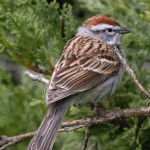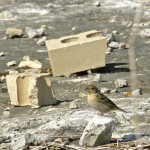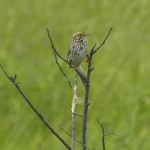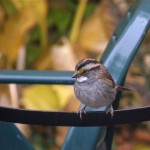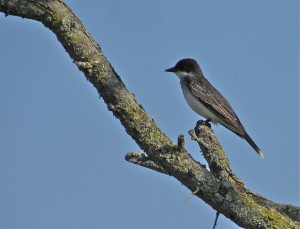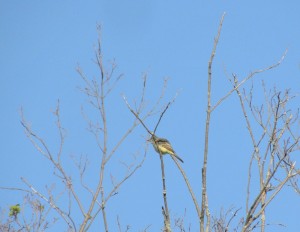8 June 2013. Norfolk County ON. I wish I could say that I actually saw a Louisiana Waterthrush, I didn’t; I heard two or maybe three. It was a day of auditory ‘sightings’ because I was in unfamiliar territory and being shown around some of Ontario’s richest birding areas by an expert who sees and hears birds that most of us miss, a knack, which, I’ve learned, comes with local familiarity and time spent in the field. I know that I see birds that others don’t simply because I’m half expecting them and am attuned to the nuances of behaviour or song that will give the bird away. It’s a bit like picking out a friend in a crowd.
This day I had joined a large group of birders on a hike organized by the Ontario Field Ornithologists, we’d been sold on the trip by the near-promise of Cerulean and Prothonotory Warblers, Acadian Flycatcher and Louisiana Waterthrush; all rare, endangered or otherwise long-shot birds.
I left home around 5.15 for a 6.30 start some 120 Km distant. I joined the group gathered on a large platform overlooking a marsh as our young leader was giving his here’s-what-to-expect briefing. As we stood listening, I thought for a moment that I heard a Least Bittern but dismissed the idea as improbable, fanciful and overly optimistic; it turned out not to be so improbable for when we returned to base at the end of the day, one was seen stalking around the edge of some cattails, although not by me. I put it down as a ‘heard-but-not-seen’, one of several this day.
We spent most of the morning in a deep, intensely green cathedral of a forest brim-full of Red-eyed Vireos, Great-crested Flycatchers and Rose-breasted Grosbeaks. We soon found (or at least heard) our first Louisiana Waterthrushes. I’d never knowingly seen one before so this was a highlight – even Bird of the Day. According to our leader, a young waterthrush brood had fledged here a day or two earlier, we could hear the parents’ tiny ‘chip’ note as they maintained contact with their hungry dependants. Then as we waited hoping for a glimpse, a Cerulean Warbler started singing close by and we followed its progress through the leafy canopy straining for a sighting, which, alas, never came. But we’d heard it – and the Louisiana Waterthrush, so clearly fortune was smiling on us.
Some hours later we tried to find Prothonotary Warblers, we checked three or four known sites, heard song at two of them but in the end had to be content with song only. Then to complete the theme of the morning we went to the only known location for Acadian Flycatcher, where again we heard but didn’t see the bird. So there it was, four longed-for birds heard but not seen, the very antithesis of the now dated adage about children: that they should be seen and not heard.
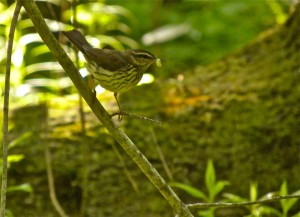
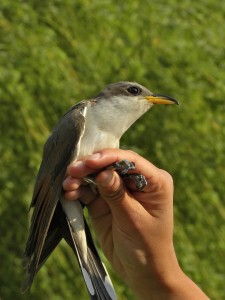
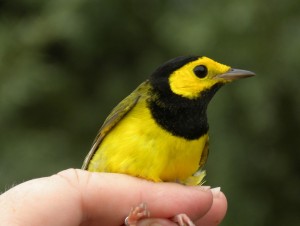
But I perhaps paint a picture of a let-down that is unjustified, for the day produced a longish list of great birds, mostly sightings. On the forest edges we encountered Eastern Towhees, Indigo Buntings, Blue-winged, Yellow, and Pine Warblers. Deep in the leafy, mosquito rich, canyons were foraging Red-bellied Woodpeckers; loud Ovenbirds calling emphatically “teacher Teacher TEACHER“; Scarlet Tanagers singing their raspy song; and Hooded Warblers all around. Eastern Wood Peewees calling “pee-a weee….pee- uur“, a family of Hairy Woodpeckers objecting loudly to our presence and a Yellow-throated Vireo trying ever so hard to sound as clear as its cousins the Red-eyed Vireos who out-sang him from every quarter. While we stood waiting and hoping for a Prothonotary Warbler a Northern Waterthrush carrying food for its young and a Yellow-billed Cuckoo calling loudly overhead made up for any waning enthusiasm.
We ended the day at every birders’ favourite, a sewage lagoon. There we saw a few shorebirds: Killdeer, Semi-palmated Plover, Spotted Sandpiper and a White-rumped Sandpiper; this last bird a distant vision seen through a telescope as it pattered among clumps of Cattails, and had it not been for the experts around me I never would have recognized or interpreted the subtle field marks that distinguished it from a nearby Least Sandpiper.
My field notes for the day recorded 55 species, Our leader tallied 70, adding in all the usual background species like American Crow, Canada Goose and the like but he also noted (among others) Ruby-throated Hummingbird, Chestnut-sided Warbler, Green Heron, Orchard Oriole and Wood Duck, none of which I recall seeing.
